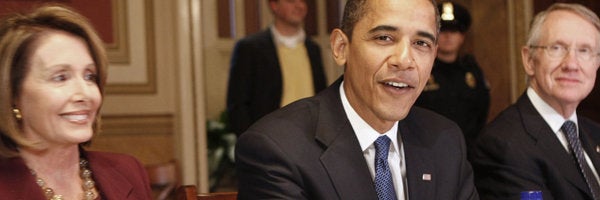
The final outline of the landmark stimulus bill poised to be passed by Congress is basically done. All that is left is putting pen to paper before both chambers vote on the measure and President Obama signs it into law.
While the total cost of the package is staggering -- roughly $789 billion -- the preponderance of attention has been paid to the minutia like money for STD prevention and reseeding the National Mall. With those provisions cut out of the package, focus has turned to a fabricated $30 million dollars to protect San Francisco mice.
That such a large and intricately detailed piece of legislation has been defined on these terms is something of a political coup for the Republican opposition. But it is also an injustice to both the enormity and potential of the bill. More than a month after the stimulus discussion began, some of its supporters still aren't entirely certain what's in it.
But that doesn't mean the information isn't available. Here are 15 expenditures, as gathered from congressional and news sources, that seem likely to have not just the most direct impact but the greatest potential to fundamentally re-shift the nation's economy.
•$7.2 billion to "increase broadband access and usage in unserved and underserved areas of the Nation."
•$16.4 for transit projects and high-speed rail: this not as much as mass-transit advocates wanted (and the total includes grants to states). But it's an important step forward on this front.
•$6 billion "for local clean and drinking water infrastructure improvements." Not only will this promote better health, it will, House Democrats say, create hundreds of thousands of jobs.
•$15.6 billion to "increase the maximum Pell Grant by $500." Education staffers on the Hill insist this will do wonders in getting lower-income children into upper-level schools. Seven million students, they say, will be helped in their pursuit of higher education.
•$3.95 billion for job training. Much of this money will be funneled through the states. The funds will not only get people to work, but create the foundation for emerging industries and companies to blossom.
•$4.5 billion to repair federal buildings and increase energy efficiency. Think short-term jobs and long-term energy cost savings.
•$2 billion in "grant funding for the manufacturing of advanced batteries systems and components and vehicle batteries that are produced in the United States." This could help the U.S. regain supremacy in the car wars.
•$11 billion for "smart-grid related activities, including work to modernize the electric grid."
•$2 billion to provide quality child care services. More parents will be able to go to work as the cost of childcare falls.
•$29 billion for highways. The one area of agreement between Republicans and Democrats: infrastructure is the quickest way to get job growth immediately.
•Tax credits "for families that purchase plug-in hybrid vehicles." This could grow up to $7,500.
•$20 billion in tax incentives to spur the use of renewable energy over the next 10 years.
•$3 billion for the National Science Foundation. This stems from an Obama campaign promise to not leave science neglected. The money will provide for "basic research in fundamental science and engineering -- which spurs discovery and innovation."
•$19 billion to accelerate adoption of Health Information Technology (HIT). Another Obama pet-project, this will modernize health care and help save billions of dollars for hospitals.
•$10 billion to "conduct biomedical research in areas such as cancer, Alzheimer's, heart disease and stem cells, and to improve NIH facilities."
Each of these items spurs job creation, saves money, or both. Taken as a whole, they represent an entirely new socioeconomic ethos among the powers that be in Washington. As one aide who helped craft the stimulus noted:
"This is the exact opposite of what Bush did. All the sudden we are putting resources into energy, education, and science. And that is stuff we have talked about forever and just haven't done ... When Bush did stuff it was all single shot. 'I'm going to do education so I'm going to create an education program. I'm going to energy so I'll do bio-fuels.' He always had one or two ideas and never a big picture strategy. And when you look at this stimulus, it matches up exactly with the big picture image that Obama pushed on the campaign trail."
